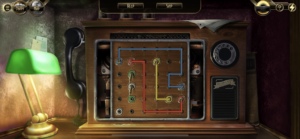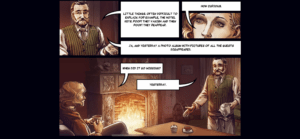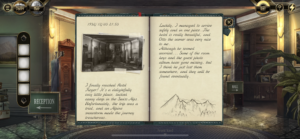For this critical play, I played “Murder in the Alps”, a free-to-play interactive murder mystery game with hidden object gameplay, created by Nordcurrent and available for Android, Microsoft Windows, and iOS (I played on an iPhone). The game is appropriate for ages 12+. Taking place in the Alps, you assume the identity of Anna Myers, a journalist from Zurich who gets roped into solving the identity of the killer who lurks amongst the hotel residents. Based on Bartle’s Taxonomy of Players, this game most appeals to “explorer” and “collector” types.
Argument: Narrative is woven into the mystery through strong associations between game locations and hidden object search missions needed to progress in the story; additionally, the dynamic and artistic delivery of key information and plot elements is unique, contributing to an evocative crime novel-like experience and sensory enjoyment. The architecture of the setting, mainly the restricted spaces of exploration within the hotel and surrounding area, provides locations for the consistent activity of hidden object tracking and completing mini puzzles, which upon solving lead to clues that help you solve the murder. The overall guiding plot of solving the murder most closely resembles a series of arcs but each subtask of finding hidden objects to look for a missing clue acts as a self-contained loop.
Upon arriving to the hotel, you are introduced to its various rooms (the reception desk, kitchen, main hall, room floors, etc) that will act as recurring settings for plot development. The photo below shows the architecture of the hotel and surrounding area.

On your first morning, you are introduced to the 10 other guests at breakfast one by one, helping set up a preliminary suspect list for the soon to happen murder. From this point on, clues (in the form of hidden objects) must be tracked down in various locations at regular intervals in order to solve an aspect of the case. Although the movement between locations in the room is a little mechanical (series of clicks to navigate), I still felt like the narrative elements contributed to the feeling of an expansive space. For example, upon arriving to room 10 on the second floor where the hotel owner and I were checking up on a missing resident, no reply was provided after knocking, prompting me to go “down” to the kitchen to retrieve a knife to break into the room. Although only one room or hallway was ever visible on the screen at a time, I still felt a sense of movement between the different hotel parts (it did not feel like static transitions between image backgrounds). The finding of clues through hidden object mini-games might have also contributed to a greater sense of “being there,” since each search took time, drawing out my presence in the location. The picture below shows a hidden object mini-game in which I was searching for a missing key (but couldn’t make use of it until all the other items on the list were found).

Unlike regular hidden object games, in each scene that is investigated, there is an object which progresses the narrative e.g. the knife. For extra challenge, there can be multiple objects of the same kind (like rings), and it’s possible that another action is required to be done before an object is found (like opening a cabinet, or collecting another object. In some cases, the objects you collect may not be used to solve a clue right away but can be stored for later, contributing to suspense and an appealing element for “collector” player types. For example, the photo below shows an empty photo album that I found in an object hunt that my player held onto because it didn’t immediately solve any clues but was an artifact mentioned earlier in the plot by the hotel owner.

I also encountered other mini-games that were tied to specific locations within the hotel but still contributed to the story progression. For example, I had to reorder the wires to a broken telephone at the reception desk, only to discover that the phone had no service due to the winter storm outside. This in-hotel action was the prompt necessary to force my character to venture beyond the hotel to ask for help. On the right are the wires (resembles the game Flow Free) that I had to reconnect within the telephone.

I found that the style of information delivery in the game did an excellent job of creating sensory fun, especially for fans of evocative narratives. Dialogue between characters is spoken aloud in distinct and authentic accents for each person (German, Swiss, French, etc) and for longer conversations, is supplemented by comic-like panels that are displayed one-at a time, in time with each snippet of speech on the screen. The auditory elements including speech, background music, and sound effects definitely enhance the feeling of being in the hotel physically and interacting with the various characters. The comic-like delivery also enhances the feel of being in a graphic novel and offers exciting visual grounding for the events occurring in the story. The picture below shows a comic-like dialogue excerpt from the story.

Also contributing to the detective identity of your player is the diary she keeps in which key story elements are recorded (done automatically with a camera). Although not a key feature of the game, the look of the diary and the camera animations (snapping a photo and the transition to developed film) add extra excitement that immerses you in the mystery and crime solving aspects of the experience. See the diary entry from day 1 below that recounts the mysterious events occurring at the hotel.



